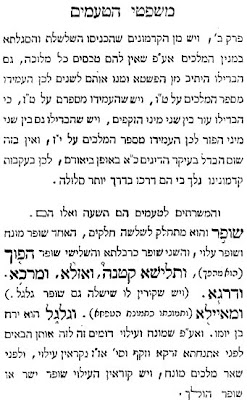 in chapter 2. And there are those of the early ones who incorporated the shalshelet and the segolta in the count of melachim, even though they do not have the tactics {rules, strategy} of all kingship; and they also divided the Yetiv from the Pashta, and counted it as two. Therefore they set up the number of melachim as 15. And there were some who set it at 16, for they divided further between the two types of Zakef. And there were those who divided also between the two types of Pazer, and therefore set the number of melachim at 17. And there is not in this any distinction at all in the primary laws except in the manner of their explanation. Therefore, we will go in the footsteps of our ancient ones, for they traveled in a path better paved.
in chapter 2. And there are those of the early ones who incorporated the shalshelet and the segolta in the count of melachim, even though they do not have the tactics {rules, strategy} of all kingship; and they also divided the Yetiv from the Pashta, and counted it as two. Therefore they set up the number of melachim as 15. And there were some who set it at 16, for they divided further between the two types of Zakef. And there were those who divided also between the two types of Pazer, and therefore set the number of melachim at 17. And there is not in this any distinction at all in the primary laws except in the manner of their explanation. Therefore, we will go in the footsteps of our ancient ones, for they traveled in a path better paved.And the meshartim {servants} for the taamim are nine. And these are they:
Shofar, and it is divided into three parts. One is the shofar munach and shofar ilui; the second is the shofar karbalta; and the third is the shofar hafuch (this is the mahpach).
And the (4) telisha katana; and (5) azla; and (6) mercha; and (7) darga. (And there are some who call it shishla, as well as shofar galgal.) And (8) me`ayla (and its form is like the form of the tipcha {except this is a mesharet rather than a melech}). And (9) galgal, this is yerach ben yomo.
And even though munach and ilui are similar to one another, those which come before etnachta, zarka, and zakef -- and its mnemonic is Azaz -- are called ilui, while those before the remainder of melachim are munach. And some call the ilui a "shofar yashar" or "shofar holech".

No comments:
Post a Comment